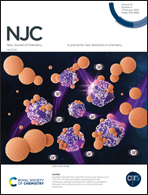Systematic regulation of ligands realizes the transition of luminescence color cuprous iodide inorganic–organic hybrid materials from blue to green light†
Abstract
As a luminescent material with excellent structural diversity and optical tunability, cuprous iodide organic–inorganic hybrid semiconductors have attracted extensive attention in the field of environmental friendly solid-state lighting (SSL). In order to systematically study how tiny changes in ligands influence the luminescence properties of their complexes, in this study, the tail atoms of ethyl groups in ligands are modified with halogen atoms (F, Cl, and Br) and four all-in-one (AIO)-structured cuprous iodide inorganic–organic hybrid semiconductor materials (Cu2I4(Ln)2) are successfully obtained. The adjustment of the tail atoms effectively regulated the stacking modes of Cu2I42− clusters and their luminescence properties, realizing the transition of the crystal luminescence color from blue to green with the internal quantum yield (IQY) increasing from 1.57% to 53.39%. Their optical diffuse reflectance spectra and density functional theory calculations (DFT) helped investigate the origin and mechanism of luminescence. They are very stable and have good solution processability, which means that they can be applied as rare-earth element-free lighting phosphors. This study can provide ideas and a theoretical basis for designing cuprous iodide cluster luminescent materials in future.



 Please wait while we load your content...
Please wait while we load your content...